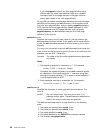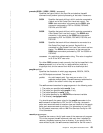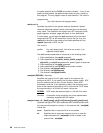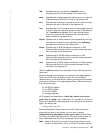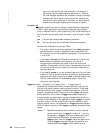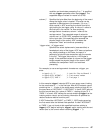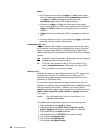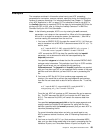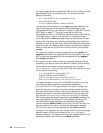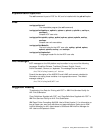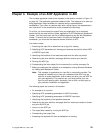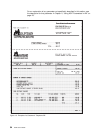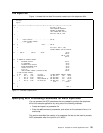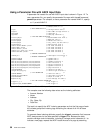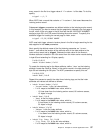are using a page definition supplied with PSF for AIX (P1A6462), and the
page definition does not name any fonts. To use the three fonts,
specify the following:
acif inputdd=MYFILE.asc outputdd=MYFILE.afp
chars=H2B2,N22,N292 \
trc=yes pagedef=P1A6462 formdef=F1A111
You specified the font names with the chars parameter. Because you
need to use fonts with the appropriate ASCII code points for your
unformatted ASCII input, you referred to Chapter 5, “IBM AFP Fonts for
ASCII Data” on page 77. There you found that the IBM Core
Interchange Font name is XH23B2 for Helvetica 12-point, XN232 for
Times New Roman 10-point, and XN2392 for Times New Roman
9-point. Because the chars parameter limits the specification of a font
name to four characters, you used the corresponding short name from
the table for each of the three fonts, without eliminating the 2-character
coded font prefix (X). Because table reference characters are required
when you want the file to print with more than one font, you specified
trc=yes.
Your input and output file names are specified with the inputdd and
outputdd parameters. The page definition and form definition you want
ACIF to use when processing the file are specified with the pagedef
and formdef parameters.
4. You have an input file and you want to use specific resources during
processing. You want to use a form definition (FORMD1A) and an overlay
that are stored in the general resource directory at your location
(/usr/site/resdir). To be sure that ACIF finds the resources you want
to use, specify the following:
acif inputdd=INFILE outputdd=OUTFILE \
pagedef=PAGED6B formdef=FORMD1A \
userlib=/usr/mystuff/art1:/usr/mystuff/art2 \
pdeflib=/usr/dept/pdefdir3 reslib=/usr/site/resdir
The page definition you want to use (PAGED6B) is stored in one of the
several page definition directories used by your department
(/usr/dept/pdefdir3). The page definition is a copy of one with the
same file name that is stored in the site’s general resource directory,
with some modifications made for use by your department. Your page
segments are stored in two other directories that you have set up for
your own use (/usr/mystuff/art1 and /usr/mystuff/art2). Because
ACIF always searches the path specified by the userlib parameter first,
your page segments will be found in your personal directories. ACIF
next searches the paths specified by the parameters for specific
resource libraries (pdeflib, fdeflib, and so forth), so ACIF will then find
the page definition you want to use from the department’s directory.
ACIF will then search the path specified with the reslib parameter,
finding your form definition and your overlay. ACIF will
not
use the page
definition named PAGED6B that is stored in the /usr/site/resdir
directory, because it will already have found the modified PAGED6B in the
department directory specified with the pdeflib parameter.
50 ACIF User’s Guide



